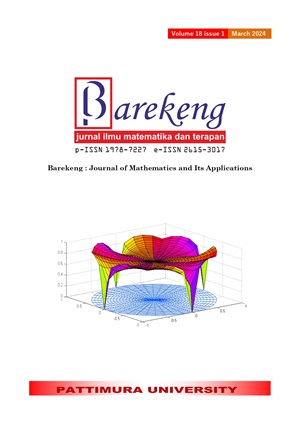IMPLEMENTATION OF MACHINE LEARNING ALGORITHM C4.5 IN CLASSIFICATION OF PATIENTS WITH TYPE 2 DIABETES MELLITUS
Abstract
The neglect of a healthy lifestyle among the Indonesian population has led to an increased risk of diabetes mellitus, which currently affects 643 million people worldwide. Early and accurate diagnosis is crucial for preventing the progression of the disease. This study utilized the C4.5 machine learning algorithm to develop a model that can classify individuals as diabetic or non-diabetic based on factors associated with diabetes. The data used in this research consisted of medical records from patients with and without diabetes at Padang General Hospital. The model's performance evaluation resulted in a recall value of 91%. By promoting a healthy lifestyle and raising awareness about the importance of regular check-ups, the burden of diabetes can be reduced, and the overall health of the population can be improved.
Downloads
References
World Health Organization, “Health and Development Through Physical Activity and Sport,” Geneva, 2003.
AIA Group, “The AIA Healthy Living Index 2018,” 2018. Accessed: Jun. 17, 2023. [Online]. Available: www.aia-financial.co.id
International Diabetes Federation, “IDF Diabetes Atlas 10th edition,” 2021. [Online]. Available: www.diabetesatlas.org
M. Maniruzzaman et al., “Comparative approaches for classification of diabetes mellitus data: Machine learning paradigm,” Comput Methods Programs Biomed, vol. 152, pp. 23–34, Dec. 2017, doi: 10.1016/j.cmpb.2017.09.004.
R. FS, B. A. Tama, and M. Mulya, “Pengembangan Perangkat Lunak Diagnosa Penyakit Diabetes Mellitus Tipe II Berbasis Teknik Klasifikasi Data,” 2010, Accessed: Jun. 30, 2023. [Online]. Available: https://repository.unsri.ac.id/8352/1/Pengembangan_Perangkat_Lunak_Diagnosa_Penyakit_Diabetes_Mellitus_Tipe_Ii_Berbasis_Teknik_Klasifikasi_Data.pdf
D. R. Ente, S. Arifin, Andreza, and S. A. Thamrin, “Comparison of C4.5 algorithm with naive Bayesian method in classification of Diabetes Mellitus (A case study at Hasanuddin University hospital Makassar),” in Journal of Physics: Conference Series, Institute of Physics Publishing, Nov. 2019. doi: 10.1088/1742-6596/1341/9/092009.
A. S. Selya and D. Anshutz, “Machine learning for the classification of obesity from dietary and physical activity patterns,” in Smart Innovation, Systems and Technologies, Springer Science and Business Media Deutschland GmbH, 2018, pp. 77–97. doi: 10.1007/978-3-319-77911-9_5.
F. Mercaldo, V. Nardone, and A. Santone, “Diabetes Mellitus Affected Patients Classification and Diagnosis through Machine Learning Techniques,” Procedia Comput Sci, vol. 112, pp. 2519–2528, 2017, doi: 10.1016/j.procs.2017.08.193.
A. Azrar, M. Awais, Y. Ali, and K. Zaheer, “Data Mining Models Comparison for Diabetes Prediction,” IJACSA) International Journal of Advanced Computer Science and Applications, vol. 9, no. 8, pp. 320–323, 2018, [Online]. Available: www.ijacsa.thesai.org
F. Gorunescu, Computational intelligence: collaboration, fusion and emergence. Berlin: Springer, 2009.
S. Klein, A. Gastaldelli, H. Yki-Järvinen, and P. E. Scherer, “Why does obesity cause diabetes?” Cell Metabolism, vol. 34, no. 1. Cell Press, pp. 11–20, Jan. 04, 2022. doi: 10.1016/j.cmet.2021.12.012.
K. Mordarska and M. Godziejewska-Zawada, “Diabetes in the elderly,” Przeglad Menopauzalny, vol. 16, no. 2, pp. 38–43, 2017, doi: 10.5114/pm.2017.68589.
S. H. Song, “Emerging Type 2 Diabetes In Young Adults,” Sheffield, 2012.
T. A. Harrison et al., “Family history of diabetes as a potential public health tool,” American Journal of Preventive Medicine, vol. 24, no. 2. Elsevier Inc., pp. 152–159, 2003. doi: 10.1016/S0749-3797(02)00588-3.
R. Watta, G. Masi, M. E. Katuuk, M. Program Studi Ilmu Keperawatan Fakultas Kedokteran Universitas Sam Ratulangi, and P. Studi Ilmu Keperawatan Fakultas Kedokteran, “Screening Faktor Resiko Diabetes Melitus Pada Individu Dengan Riwayat Keluarga Diabetes Melitus Di Rsud Jailolo,” Jurnal Keperawatan (JKp), vol. 8, pp. 44–50.
E. Alpaydin, Introduction to Machine Learning, 3rd ed. London: The MIT Press, 2014.
Z.-H. Zhou, Machine Learning. Nanjing: Tsinghua University Press, 2021. doi: 10.1007/978-981-15-1967-3.
B. Rajoub, “Supervised and unsupervised learning,” in Biomedical Signal Processing and Artificial Intelligence in Healthcare, Elsevier, 2020, pp. 51–89. doi: 10.1016/B978-0-12-818946-7.00003-2.
Copyright (c) 2024 Dyah Ayu Sekar Kinasih Purwaningrum, Dina Agustina

This work is licensed under a Creative Commons Attribution-ShareAlike 4.0 International License.
Authors who publish with this Journal agree to the following terms:
- Author retain copyright and grant the journal right of first publication with the work simultaneously licensed under a creative commons attribution license that allow others to share the work within an acknowledgement of the work’s authorship and initial publication of this journal.
- Authors are able to enter into separate, additional contractual arrangement for the non-exclusive distribution of the journal’s published version of the work (e.g. acknowledgement of its initial publication in this journal).
- Authors are permitted and encouraged to post their work online (e.g. in institutional repositories or on their websites) prior to and during the submission process, as it can lead to productive exchanges, as well as earlier and greater citation of published works.






1.gif)



